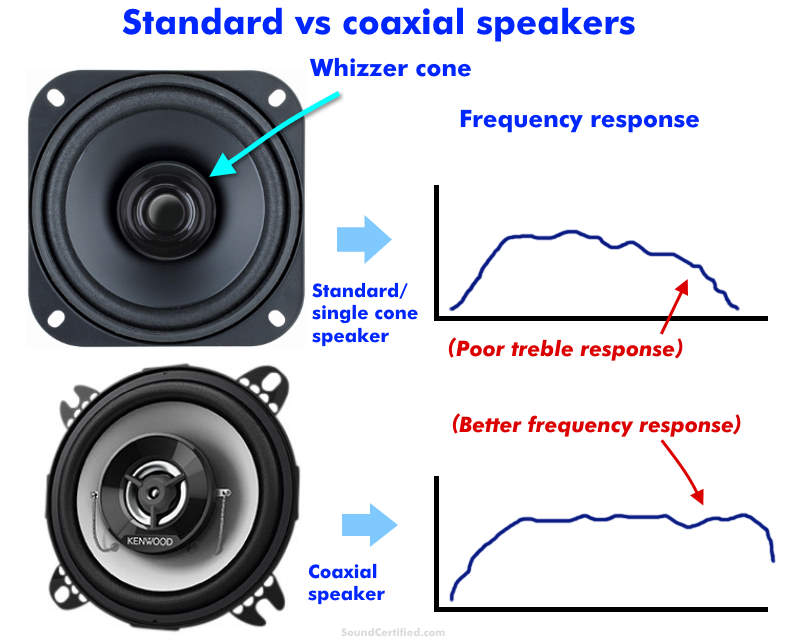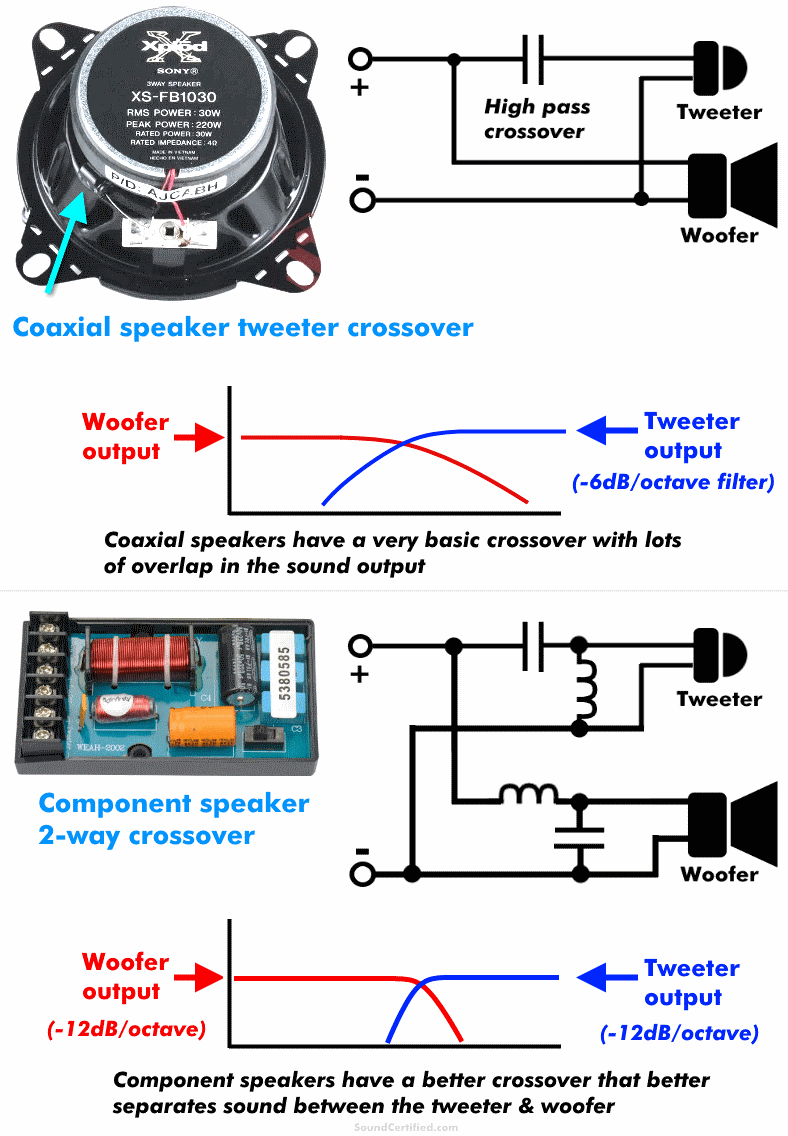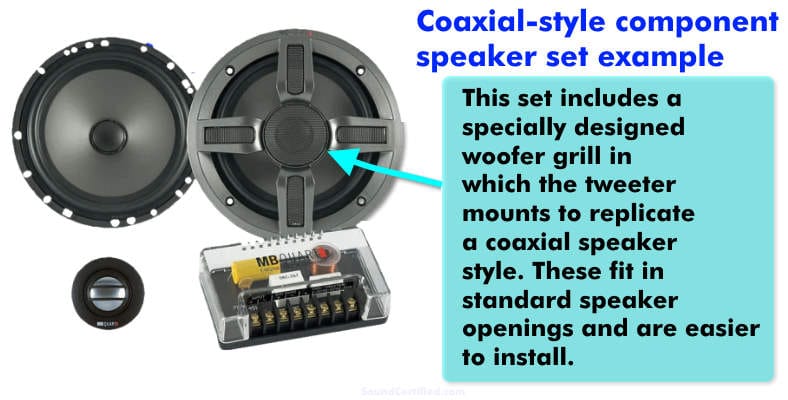If you’re serious about good sound it’s helpful to understand the difference between coaxial and component speakers – along with why it matters.
In this article I’ll show you:
- The pros and cons of coaxial and component speakers.
- What type of sound coaxial and component speakers put out.
- Which one is best for you – and if there’s really a “better” choice.
- Installation details that matter.
There’s a lot to cover so read on!
Contents
What is the difference between coaxial and component speakers?
What are coaxial speakers?
Coaxial car speakers are a 2-way speaker system built together: the tweeter, woofer, and a simple crossover are assembled into one speaker assembly. They replace older & lower-quality speakers by fitting in the same installation space in many cases.
Coaxial speakers use a 2-way speaker design with a tweeter, woofer, and a simple crossover built into a single speaker assembly. Most provide a woofer cone with a separate tweeter for good full-range sound quality and frequency coverage unlike cheaper single-cone speakers.
Think of coaxial speakers as a compromise between single cone speakers (the cheapest type of speaker, with poor sound quality) and a more advanced component speaker system. They’re very popular as they offer good sound quality but don’t cost as much as more expensive speaker options.
Coaxial speakers have some great advantages:
- Easy sound upgrade: they’re a drop-in replacement for older factory-installed & bad sounding single cone speakers.
- There’s a wide range of performance & price options for buyers: different levels of tweeter quality, crossover design, cone materials, higher power ratings, and so on.
- They give somewhat similar performance to separate 2-way component car speakers – but without the need for a separate speaker crossover you have to install, too.
- They’re easy to find and very popular – in fact, they’re the most popular car speaker upgrade and it’s really easy to find them when shopping.
- Affordability: good coaxial car speakers can be found for around $25 and up. Very good quality coaxials are only about $50-$65 or so.
- Coaxial speakers can immediately fix the poor frequency response many people have with their older speakers.
Coaxial vs standard/single cone speakers
Coaxial speakers provide much better sound than standard low-end single cone speakers – even those with a whizzer cone added to supposedly improve the sound. Coaxial speakers use a 2-way design where the job of producing full-range sound is split between them for best results.
The typical car speakers you’ll find in many vehicles and home stereo systems are terrible! They’re well-known for bad sound and have been one of the single biggest complaints from my car stereo installation customers for years.
But why? As you can see in my picture above, they’re bad sounding because they only have a single speaker (woofer/midrange)which isn’t enough to cover the full frequency range.
The truth is that single cone speakers can’t produce great sounding music like coaxial models. Coaxial speakers fix this by using a tweeter to take care of the upper end of the musical sound range, filling in what other speakers can’t produce.
2-way vs 3-way coaxial speakers
3-way coaxial speakers are simply an extension of 2-way models with an additional small speaker (usually another tweeter or type of mid range) added for extra sound performance.
It’s important to understand that just because they might look better doesn’t mean they sound better than a very good 2-way model. Some definitely do have improved sound production, however.
For example, some 3-way full range speakers add a tiny piezo type tweeter that can exceed the upper-frequency limit of standard tweeters, allowing for enhanced sound. Really good models offer not just a higher range of sound frequencies but a nearly flat sound response which is ideal.
The main thing to take away is that a quality and well-designed 2-way speaker can give great sound and most of the time is your best value for the dollar. Don’t spend the time, effort, and money chasing after 3-way speakers due to thinking they’re better just because of the added speaker.
Like many other things, it comes down to the quality and the design details. I recommend shopping primarily for a good quality 2-way coaxial speaker set.
What are component speakers?
Component speakers use separately mounted speakers and a more advanced crossover to provide better sound quality. They’re the next level above coaxial speakers and offer better performance.
Components speakers, which are made up of a separately mounted woofer, tweeter, and crossover, are a more advanced speaker system that provides better sound quality than coaxial speakers.
One reason for this is that component speakers often use better dome tweeter and woofer materials along with a more advanced (and better) speaker crossover. They may also include features such as a tweeter volume reduction option, tweeter fusing to protect against overload, and additional wiring configurations.
Some are even designed to allow assembling them together so they resemble coaxial speakers for easier installation.
Unlike coaxial speakers, component speakers offer:
- Better frequency response and sound accuracy overall – even entry-level component speaker sets can have really great sound quality!
- Tweeters with a more rigid and high-performance design: silk, aluminum, ceramic, or other special dome materials are common.
- More power handling – often 75 watts RMS, 100 watts RMS, or more.
- -12dB per octave crossover slopes (or greater) versus the standard -6dB/octave crossover used on coaxial tweeters.
- Better crossover component quality.
- Better speaker connector terminals and installation accessories.
- The ability to mount the tweeters at a line-of-sight listening angle and height for better stereo imaging during music playback.
That being said, it’s important to understand that the installation process is harder than for coaxial speakers and can require custom fabrication for the tweeter mounts. Also, you’ll need to mount the crossovers as well, ideally away from moisture, and relatively close to where the speakers are mounted.
They’re also a bit more costly, too, as many component speaker sets cost around 1.5x to several times more than coaxials of the same size.
I’ve been a longtime user of component speakers and love them. Hands down, I can confidently say that a good (not even the most expensive model!) set of them can sound fantastic when used properly and powered by an amplifier.
Coaxial vs component speaker crossover differences
Shown here is a diagram comparing coaxial vs component speaker crossovers. Coaxial speakers normally use a simple high-pass crossover only for the tweeter to block bass and none for the woofer. The result is overall good sound but with room for improvement. Component speakers, however, use a more advanced crossover design that filters unwanted sound frequencies from reaching the woofer or tweeter. The result is less distortion, more accurate sound, and a better listening experience.
As I mentioned before, component speakers use more advanced crossovers than coaxials. They use 2 stages of filtering vs the single stage used with coaxials. This means more effective filtering of bass and midrange sound from the tweeter and more high-range sound is blocked from the woofer.
Most coaxials use a single cheap capacitor connected to the tweeter mounted and nothing for the woofer. Instead, they use a lower-cost design that relies on the fact that most woofers “roll off” (gradually stop producing) higher frequencies naturally.
Although it gets the job done and it works, there’s still room for improvement and the sound quality is compromised.
Component speaker crossovers use a better design
Component speakers, by comparison, use an external crossover designed for the specific speakers used and are made using better quality capacitors and inductors. They’re much more effective at preventing unwanted sound frequencies from reaching the speakers that aren’t suited for them.
The end result is much better clarity & lower distortion, allowing you to better hear the music as it was intended to be heard.
Even better, some component speaker crossovers include a tweeter volume control option. This is helpful if the tweeter seems too harsh sounding to you. Some also include tweeter overload circuit protection to avoid burning them out during high power delivery.
Wiring component speakers and coaxial speakers
Both types of speakers are fairly easy to wire – aside from the additional wire & labor needed for mounting component speakers properly.
Here’s a simple breakdown of the wiring connections needed:
- Coaxial speakers: wired from the head unit or amplifier positive wire and negative wire to the same terminals on the speaker, same as factory-installed speakers. (Note that when replacing some factory-installed “premium” speaker systems, you may need to run new speaker wire to bypass the troublesome original wiring).
- Components:
- Connected from the head unit or amplifier’s speaker outputs to the INPUTS of the speaker crossover.
- Connect the tweeter output of the crossover to the tweeter’s positive and negative terminals.
- Connect the woofer output from the crossover to the woofer’s positive and negative terminals.
Shown here is a typical component speaker installation: the woofer, tweeter, and crossover are mounted inside a car door. This is a pretty common installation and gives excellent sound, although it takes more time & money to complete.
Which is better, coaxial or component speakers?
The best way for me to answer this question depends on what the definition of “better” means to you. After all, you’re the best judge of what you like, right?
The simplest answer is that component speakers are the best in terms of sound quality, power handling, tweeter & woofer technology options, and installation creativity.
However, that’s not what everyone needs – not everyone cares about super-crisp sound, more power handling, or better speaker crossovers. Perhaps the best thing for me to do is to simplify it with a short comparison below.
There are several differences between coaxial speakers and component speakers you should know:
- Coaxial speakers fit the entire 2-way speaker system into a single speaker assembly. Most component speaker systems (aside from a few rare designs) are separate and everything has to be mounted individually.
- Coaxial speakers, in order to keep costs down and fit into a small space, have some compromises. A basic -6dB/octave crossover for the tweeter and many use a lower-cost tweeter material. Component speakers, however, have better crossovers (-12dB/octave minimum, usually) and better tweeter materials like silk, aluminum, or others.
- Coaxial speakers tend to have lower power ratings while component speakers tend to have higher power rating limits. Coaxials tend to range around say 35W-65W RMS or so while components typically are available in 65W-100W RMS or higher options.
- Coaxial speakers are simple to install while component speakers are harder and take more time & effort.
- Component speakers, because of their design, offer better sound quality and clarity than coaxial speakers. Coaxials are good, but many are average (however, still much better than standard single-cone speakers).
It’s a lot easier to find coaxial speakers when shopping than it is to find component speakers. Coaxial speakers, as I mentioned earlier, are a lot more popular and because of it, many stores have them in stock.
Even your local department store, auto parts store, and “mom and pop” electronics stores probably has some in the car audio section.
Coaxial speakers are great for budget sound!
As far as price is concerned, prices for component speakers start at about the same price as a very good pair of coaxial speakers. You’ll pay less for coaxial speakers and have more options to choose from depending on what you can afford.
For example, I installed quite a few average-quality coaxial speakers in cars, trucks, and even boats over the years. They’re good enough for many people yet still within reach of what they could afford when you add in the cost of installation.
Most of the time you can expect to pay somewhere around $45 for good coaxials and about $75-$100 for a good component set.
Should I get component or coaxial speakers?
Here’s a comparison to help you decide if you’re unsure.
You should get coaxial speakers if:
- You don’t have a lot to spend or just need something that’s good enough to sound ok – not “high end” sound
- You want an easy way to replace your old speakers
- You’re not planning to amplify your speakers and will use a standard stereo
- You don’t want to do the extra work or run extra wire needed for component speakers
- You don’t have the time, tools, or money to spare on a custom installation
You should get component speakers if:
- Sound quality is what you’re mainly after
- Want to use speakers with more advanced materials (especially for the tweeters)
- You prefer speaker crossovers with a steeper cutoff and/or tweeter volume reduction option
- Will be doing a custom home, car stereo, or marine speaker installation with higher-end electronics
- You want improved stereo imaging for music playback and critical listening with high-fidelity recordings
- You would like to drive your speakers with an amplifier for extra power and clarity
The good news is that there are some component speaker systems that can be used a lot like component speakers, making them easier to install. You’ll save a lot of work & hassle in the process.
As I noted above, component speakers should be driven with an amplifier for the best results. You simply won’t get great sound from them using a low-power stereo unit.
An example of a component speaker set (in this case by speaker company MB Quart) that can be put together to work like a coaxial speaker for easier installation and using less space.
Do I need an amp for component or coaxial speakers?
It would be a bit misleading to say you “need” an amp for your speakers. The better thing for me to say is that there are some great advantages you’ll get by using an amplifier to drive component or coaxial speakers.
Here’s a list of reasons why amplifying your speakers is a good idea:
- Lower distortion & cleaner sound
- The ability to block power-robbing & distorting low-end bass by using a crossover
- Lots of power available for much more volume
- A lot more flexibility for system set up
For example, most car stereo units, despite the misleading advertising they have, output only about 15-18 watts RMS per channel at the most.
And that’s not clean, great-sounding power, either. They’ll start to distort badly and sound poorly when pushed to their maximum output.
You’ll be fine for every day listening to your speakers at a moderate to moderately high volume with a good car stereo head unit. However, using an amp can take your audio system to the next level.
How does an amp make speakers sound?
Using an amplifier (even a decent one, not a high-end unit) can make a big difference in how your car audio system sounds. Amplifiers will provide several sound options you can’t get from a head unit – even the expensive ones!
Here’s a list of what an amplifier can offer:
- Built-in high pass crossovers to block distorting and power-robbing low end bass your speakers can’t handle
- Higher signal-to-noise (SNR) ratio, giving better clarity than a head unit can provide
- Much better listening volume & power left over, without the high distortion you get when you crank up a head unit
- More installation options and bass boost
I’ve been powering my component speakers with amplifiers for years and it’s like a night and day difference in sound quality! It’s a bit more work, but well worth it and I’ve had readers report exactly the same too.
I recommend using a decent quality amplifier with 50 watts RMS per channel or higher for best results.











